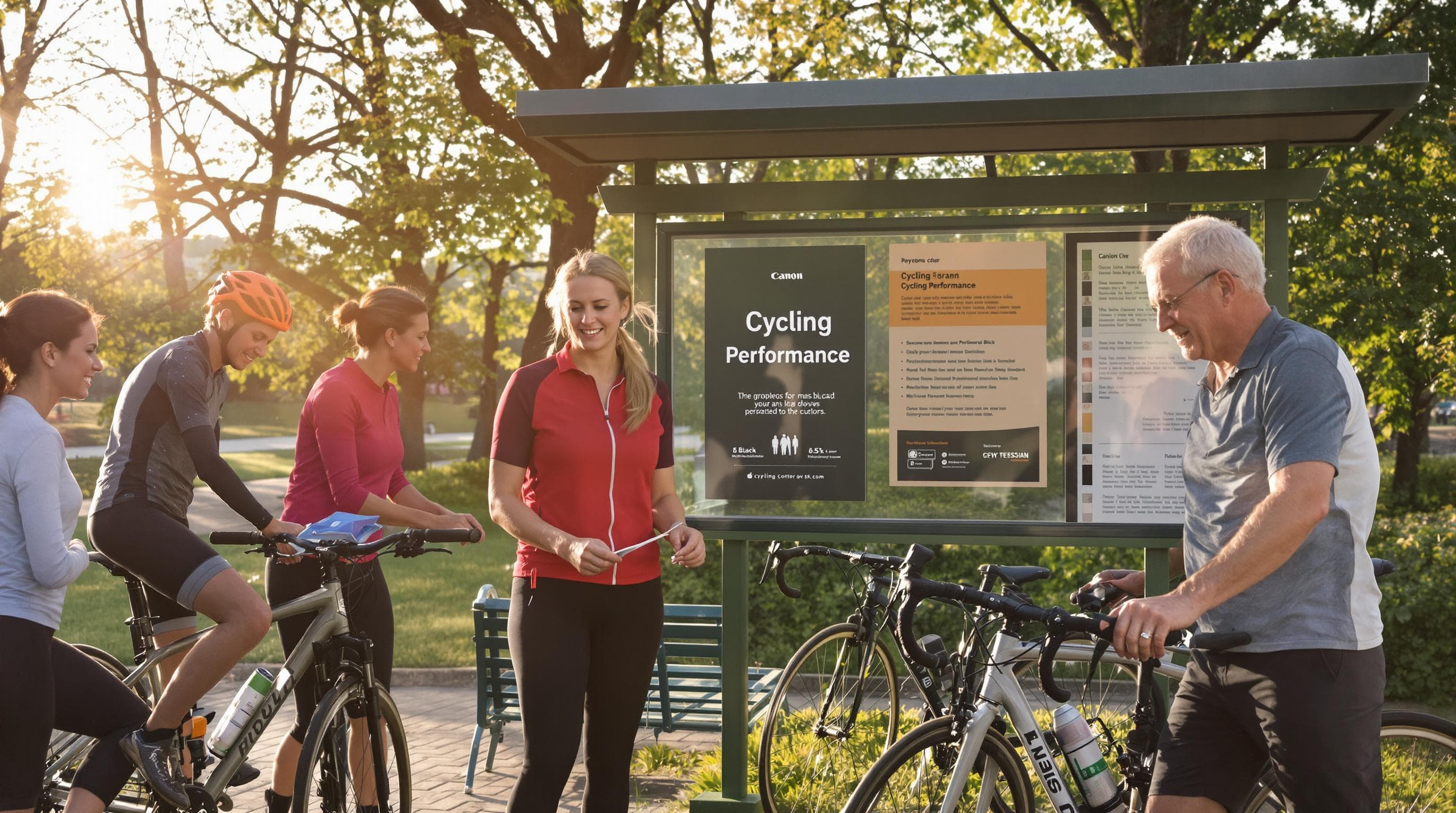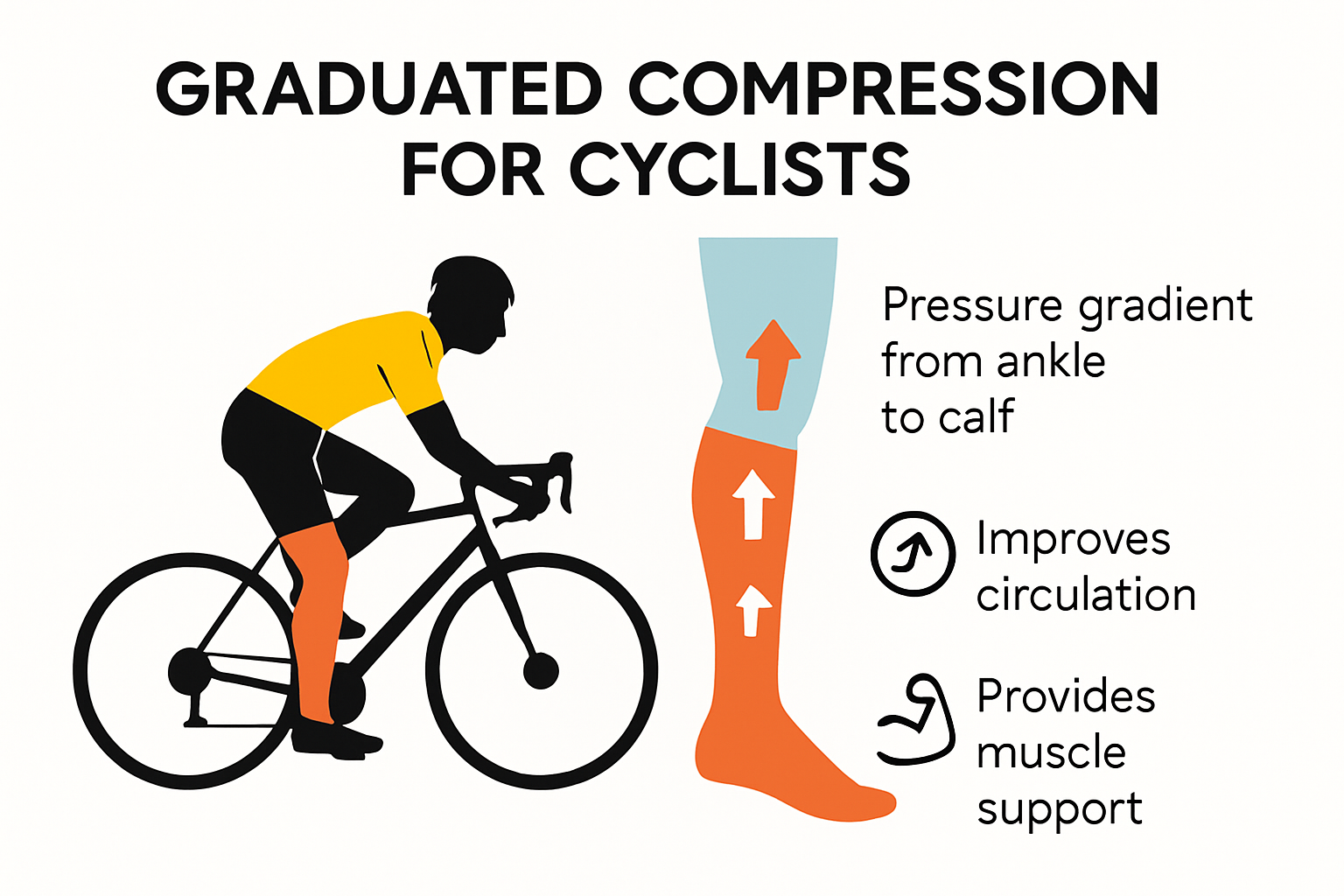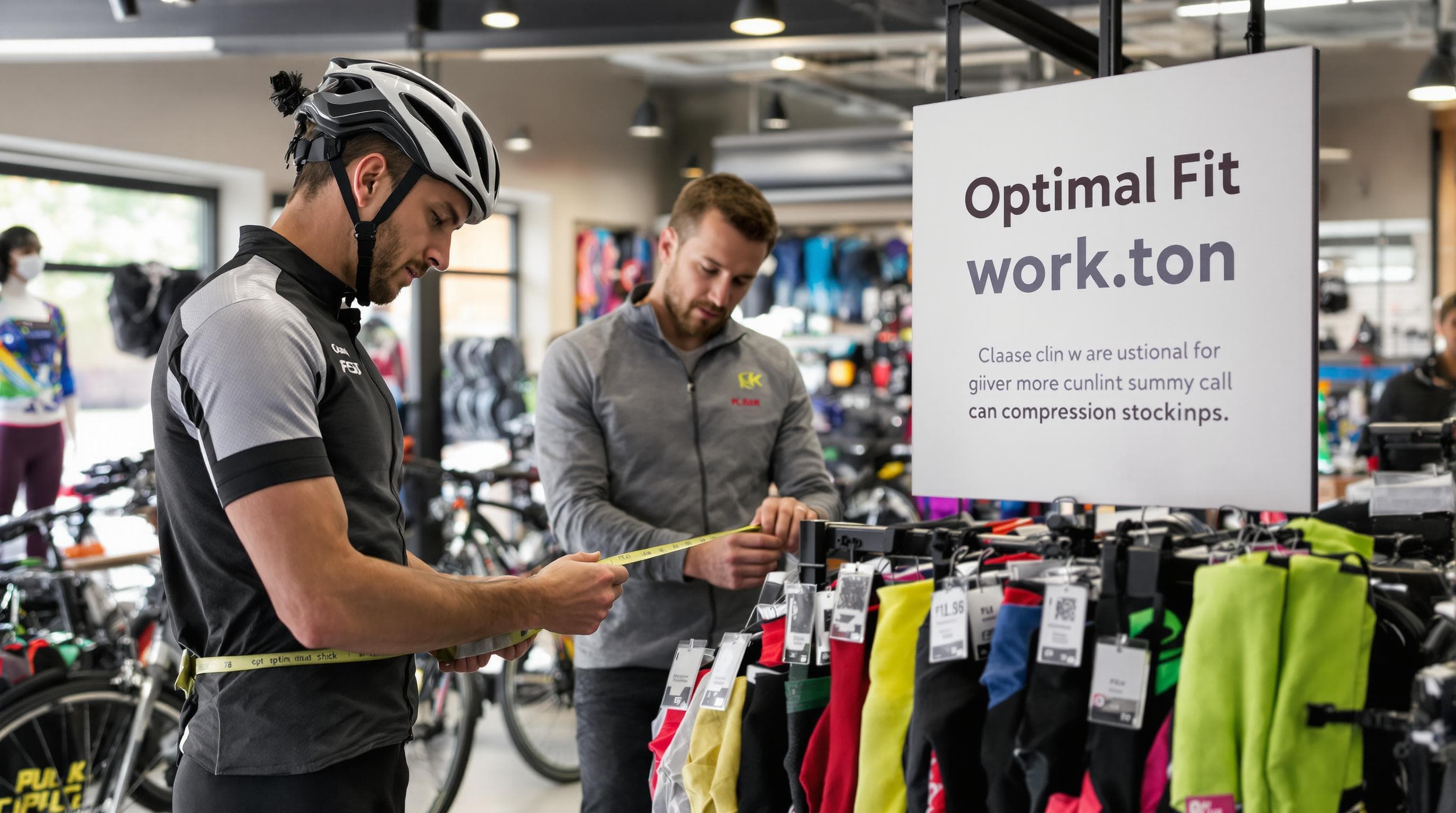
Compression Stockings for Cycling: Health Benefits for 2025
Share

Compression stockings have become a must-have for cyclists aiming to push harder and recover faster. Sounds like just another fitness trend, right? Actually, studies show that athletes wearing compression stockings can see as much as a 1% improvement in performance and noticeably lower heart rates during intense rides. That might sound small, but for dedicated cyclists, this modest number is enough to change the outcome of a race—and help you feel fresher after every ride.
Table of Contents
- How Compression Stockings Work For Cyclists
- Health Benefits For Vein And Circulatory Conditions
- Choosing The Right Compression Stockings For Cycling
- Tips For Safe Use And Maximum Effectiveness
Quick Summary
| Takeaway | Explanation |
|---|---|
| Compression stockings enhance blood circulation. | They apply graduated pressure, promoting efficient blood flow back to the heart during cycling. |
| Optimal fit improves performance and recovery. | Proper sizing and compression gradient can enhance muscle oxygen delivery and reduce soreness post-activity. |
| Use stockings during intense training sessions. | Wearing them while cycling can maximize performance benefits and accelerate recovery times afterwards. |
| Follow proper application techniques for effectiveness. | Smooth application and wearing them early prevents discomfort and promotes effective compression throughout workouts. |
| Regular maintenance is essential. | Wash and replace compression stockings every 3-6 months to maintain their performance and support. |
How Compression Stockings Work for Cyclists
Compression stockings create a specialized performance environment for cyclists by applying graduated pressure to the lower limbs, strategically enhancing blood circulation and muscle support during intense cycling activities. Understanding their biomechanical principles reveals why these garments have become essential equipment for both professional and amateur cyclists.

The Science of Graduated Compression
Compression stockings operate through a precise pressure gradient mechanism that promotes enhanced venous return and muscle efficiency. Learn more about compression technology reveals how these garments apply maximum pressure at the ankle, gradually decreasing pressure as they move up the leg. This design encourages blood flow back toward the heart, reducing muscle fatigue and potential swelling.
According to research published in the Journal of Strength and Conditioning Research, compression garments can improve peak power output and increase muscle blood flow during cycling. The study demonstrated that strategic compression enhances oxygen delivery to active muscles, potentially improving overall cycling performance. By applying consistent, graduated pressure, these stockings create a supportive environment that minimizes muscle oscillation and reduces the energy typically lost through muscle vibration during intense pedaling.
Performance and Recovery Mechanisms
Cyclists experience significant physiological stress during training and competition, making compression stockings a critical recovery tool. Research in the European Journal of Applied Physiology highlighted that compression tights enhance hemodynamic responses, including increased stroke volume and cardiac output during recovery. These physiological improvements translate into tangible benefits for cyclists:
- Improved Circulation: Compression stockings help push deoxygenated blood back to the heart more efficiently
- Reduced Muscle Vibration: Minimizes energy loss and potential muscle microtrauma during cycling
- Enhanced Recovery: Supports faster muscle repair and reduces post-exercise inflammation
The International Journal of Sports Physiology and Performance further confirmed these benefits, noting that compression garments can contribute to lower heart rates during fixed-intensity cycling and provide marginal improvements in mean power output. This suggests that beyond immediate performance, compression stockings offer cyclists a nuanced approach to managing physiological stress and optimizing muscular efficiency.
Whether you are a competitive cyclist or a weekend enthusiast, compression stockings represent more than just athletic wear. They are a scientifically designed performance enhancement tool that supports your body’s natural physiological processes, helping you push boundaries while minimizing recovery time and potential muscle strain.
Health Benefits for Vein and Circulatory Conditions
Compression stockings offer significant therapeutic advantages for individuals struggling with various vein and circulatory conditions, providing a non-invasive solution to manage complex cardiovascular challenges. These specialized garments represent more than just medical accessories they are critical tools in supporting overall venous health and preventing potential complications.
Enhancing Venous Return and Circulation
Explore our comprehensive guide to compression benefits reveals the fundamental mechanism behind compression stockings. According to Harvard Health, compression socks systematically squeeze the legs, dramatically improving blood circulation and reducing potential risks associated with poor venous function.
The strategic pressure gradient applied by compression stockings creates a powerful physiological response. By applying consistent external pressure, these garments effectively counteract gravitational forces that typically cause blood to pool in lower extremities. This mechanism is particularly crucial for individuals with compromised circulatory systems, helping to prevent conditions like chronic venous insufficiency, deep vein thrombosis, and peripheral edema.
Targeted Treatment for Specific Circulatory Disorders
The Cleveland Clinic emphasizes that compression therapy can effectively address multiple circulatory health challenges. Patients experiencing conditions such as varicose veins, lymphedema, and diabetic circulation problems can benefit significantly from targeted compression support.
Compression stockings provide specialized interventions for various circulatory disorders:
- Varicose Vein Management: Reduces visible vein swelling and alleviates associated discomfort
- Deep Vein Thrombosis Prevention: Minimizes blood clot formation risk during extended sedentary periods
- Lymphatic System Support: Encourages fluid drainage and reduces chronic swelling
According to Tallahassee Memorial Health, the pressure mechanism helps redirect blood flow more efficiently, reducing strain on venous walls and promoting healthier circulatory dynamics. This approach not only addresses existing conditions but also serves as a preventative strategy for individuals at higher risk of circulatory complications.
For patients managing chronic conditions, compression stockings represent a proactive healthcare solution. By supporting natural physiological processes, these garments offer a non-pharmaceutical approach to managing complex circulatory challenges, empowering individuals to maintain mobility, reduce discomfort, and potentially prevent more serious health interventions.
Choosing the Right Compression Stockings for Cycling
Selecting the ideal compression stockings for cycling requires careful consideration of multiple factors that directly impact performance, comfort, and physiological support. Cyclists must navigate a complex landscape of sizing, compression levels, material technologies, and specific design features to find the perfect garment for their individual needs.
Understanding Compression Levels and Fit
Discover expert tips for compression sock selection highlights the critical importance of precise measurements and appropriate compression gradients. According to research published in the International Journal of Sports Physiology and Performance, compression garments with optimal fit can provide performance improvements of approximately 1% and enhance oxygen delivery to exercising muscles.
Cyclists should focus on three primary considerations when selecting compression stockings:
- Compression Gradient: Choose between 15-20 mmHg (mild), 20-30 mmHg (moderate), or 30-40 mmHg (firm) based on individual health needs and cycling intensity
- Material Composition: Select breathable, moisture-wicking fabrics like nylon and spandex blends that provide durability and comfort
- Size Precision: Measure calf circumference and leg length accurately to ensure proper pressure distribution
Below is a summary table to help you compare the main factors to consider when choosing compression stockings for cycling.
| Factor | Options/Values | Importance for Cyclists |
|---|---|---|
| Compression Gradient | 15-20 mmHg (mild), 20-30 mmHg (moderate), 30-40 mmHg (firm) | Matches pressure needed for health needs and training intensity |
| Material Composition | Nylon/spandex blends, moisture-wicking fabrics | Ensures comfort, breathability, durability |
| Size Precision | Accurately measure calf circumference and leg length | Promotes proper pressure distribution & avoids constriction |
| Specialty Features | Seamless, antimicrobial, UV protective, support zones | Enhances comfort, hygiene, outdoor suitability, and muscle support |
Performance and Comfort Optimization

Research from 2021 demonstrated that sports compression garments can significantly improve subsequent cycling performance by enhancing hemodynamic responses and reducing muscle soreness during recovery. When selecting compression stockings, cyclists should evaluate additional performance-oriented features:
- Seamless construction to prevent chafing
- Targeted muscle support zones
- UV protection for outdoor cycling
- Antimicrobial fabric treatments
A 2018 study in sports performance research confirmed that lower-limb compression garments can improve muscle blood flow and reduce heart rate during exercise, underscoring the importance of selecting high-quality compression stockings specifically designed for cycling activities.
Ultimately, choosing the right compression stockings is a personalized process that balances scientific performance metrics with individual comfort preferences. Cyclists should consider their specific training goals, existing health conditions, and personal physiological responses when making their selection. Consulting with sports medicine professionals or experienced cycling coaches can provide additional insights into finding the most suitable compression stockings for optimal performance and recovery.
Tips for Safe Use and Maximum Effectiveness
Maximizing the benefits of compression stockings requires a strategic approach that goes beyond simply putting them on before cycling. Cyclists must understand the nuanced techniques for safe application, optimal wear, and proper maintenance to ensure these performance-enhancing garments deliver their full potential.
Proper Application and Wear Techniques
Learn essential care techniques for your compression gear provides crucial insights into effective compression stocking use. According to a systematic review analyzing multiple sports performance studies, wearing compression stockings strategically can improve muscle function and reduce perceived muscle soreness during recovery.
Cyclists should follow these critical application guidelines:
- Smooth Application: Carefully roll stockings up the leg without creating wrinkles that might disrupt pressure distribution
- Morning Application: Put on compression stockings before significant leg swelling occurs, ideally in the morning
- Proper Fit Check: Ensure no bunching or excessive tightness that could restrict circulation
The following table organizes key steps and tips for safe and effective application of compression stockings for cyclists.
| Step | Description |
|---|---|
| Smooth Application | Roll stockings up without wrinkles to maintain even pressure |
| Morning Application | Put on stockings in the morning before swelling starts |
| Proper Fit Check | Ensure there is no bunching or excessive tightness that can impede circulation |
| Regular Inspection | Check for signs of wear or loss of elasticity |
| Hygiene Practices | Wash regularly and avoid direct heat to preserve fabric integrity |
Performance and Recovery Optimization
Research involving highly trained cyclists revealed that compression garments can provide performance improvements, albeit subtle. The study demonstrated a trivial performance enhancement of approximately 1% and observed lower heart rates during fixed-intensity cycling, suggesting improved oxygen delivery to muscles.
To maximize effectiveness, cyclists should consider these strategic usage recommendations:
- Wear compression stockings during intense training sessions
- Use during post-cycling recovery to reduce muscle soreness
- Alternate between different compression levels based on training intensity
A detailed study on repeated-sprint cycling demonstrated that lower-limb compression tights could improve peak power output and increase muscle blood flow. This research underscores the importance of selecting and using compression stockings with precision and understanding.
Additionally, cyclists should be aware of potential limitations. While compression stockings offer numerous benefits, they are not a universal solution. Individual physiological responses vary, and what works perfectly for one cyclist might not yield identical results for another. Regular consultation with sports medicine professionals can help refine your compression stocking strategy.
Maintaining your compression stockings is equally crucial. Proper washing, avoiding direct heat, and replacing them periodically ensures continued effectiveness. Most compression stockings maintain optimal performance for approximately 3-6 months with proper care, after which their elastic properties may degrade.
Ultimately, compression stockings represent a sophisticated tool in a cyclist’s performance and recovery arsenal. By understanding their scientific principles, applying them correctly, and maintaining them diligently, cyclists can unlock their full potential for enhanced performance and reduced muscle fatigue.
Frequently Asked Questions
What are the benefits of wearing compression stockings while cycling?
Wearing compression stockings can enhance blood circulation, reduce muscle vibration, improve recovery time, and lower heart rates during intense rides.
How do compression stockings work for cyclists?
Compression stockings apply graduated pressure to the lower limbs, promoting efficient blood flow back to the heart, reducing muscle fatigue, and improving overall muscle efficiency during cycling.
How do I choose the right compression stockings for cycling?
Select compression stockings based on the compression gradient (15-20 mmHg, 20-30 mmHg, or 30-40 mmHg), consider breathable materials, and ensure you measure for proper fit to promote effective pressure distribution.
How often should I replace my compression stockings?
Compression stockings should be washed regularly and replaced every 3-6 months to maintain their performance and supportive properties.
Upgrade Your Cycling Experience With Proven Compression Technology
When you push hard on the bike, you want every edge you can find. The article explained how compression stockings enhance circulation, help muscle recovery, and support vein health during long rides and tough training. If you battle with heavy legs, lingering soreness, or concerns about vein health, you know how much even a small boost in comfort and performance can matter. You do not have to leave those results to chance. Fit Stockings offers a wide range of medical-grade compression stockings to match your goals, whether you need mild support or a stronger gradient to manage more serious venous issues.
Lift your game now by exploring our curated selection from trusted brands like Jobst, specially designed for athletic use and daily recovery. Discover personalized sizing guides, free shipping, and our easy returns policy for true buying confidence. Let Fit Stockings help you ride stronger and recover smarter this season. Shop today for faster muscle recovery and healthier legs on every ride.
Recommended
- Knee High Compression Stockings: Health Benefits and Guide 2025 – Fit Stockings
- Fashionable Compression Stockings: Stylish Support for 2025 – Fit Stockings
- Compression Stockings for Athletes: 2025 Guide to Better Health – Fit Stockings
- The Ultimate Guide to Compression Stockings: Comfort, Health, and Styl – Fit Stockings

